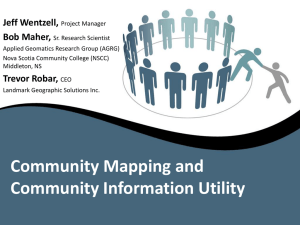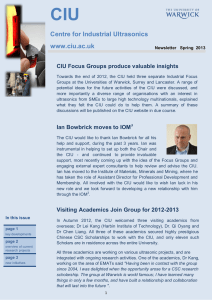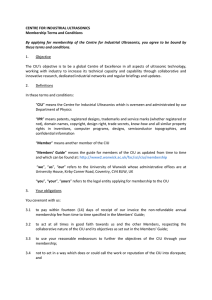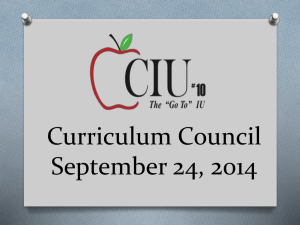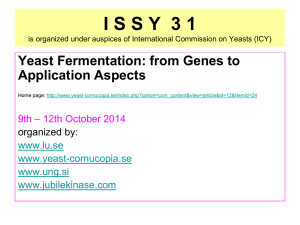Community Information Utility Project
advertisement
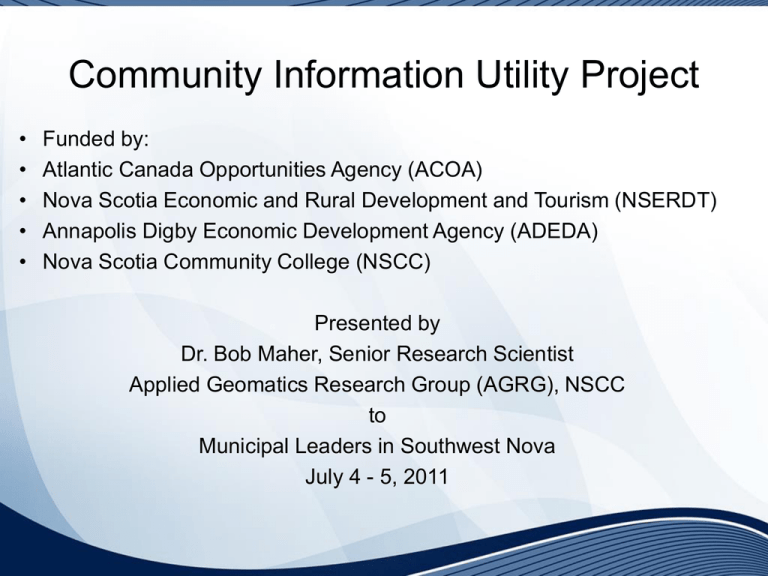
Community Information Utility Project • • • • • Funded by: Atlantic Canada Opportunities Agency (ACOA) Nova Scotia Economic and Rural Development and Tourism (NSERDT) Annapolis Digby Economic Development Agency (ADEDA) Nova Scotia Community College (NSCC) Presented by Dr. Bob Maher, Senior Research Scientist Applied Geomatics Research Group (AGRG), NSCC to Municipal Leaders in Southwest Nova July 4 - 5, 2011 Outline 1) 2) 3) 4) 5) 6) 7) Background Definition of CIU Feasibility Study Time Line Purpose of the visit Opportunity for input Questions What is a Community Information Utility? The concept of a Community Information Utility (CIU) is complex. Paul Beach offers the following description from Sault Ste Marie: “Like a water utility or electric utility, an information utility provides information services including data hosting and data analysis within a community. This new model has resulted in the cooperative, efficient and cost effective sharing of information amongst community organizations and partners. With the emergence of the Sault Ste Marie CIU, the analysis of shared information has led to significant improvements in the overall health, public safety and operational efficiency of the community.” Description of CIU concept in Sault Sainte Marie • Main proponents – City of Sault Ste Marie – Utility • Initial investment in building spatial data warehouse • Spent 5 years building spatial database at cost of $5m Description of CIU concept in SSM • Once created, then CGC was able to develop large number of GIS applications • Questions for Paul Beach – – – – – Involvement of private sector Not-for-profit model Significant Health and Utility applications Not a rural setting Advice on governance structure Background History - visit by Paul Beach, SSMIC May 2010 - draft proposal to ACOA - Feasibility study funded by Team Southwest partners Feasibility Study of Community Information Utility for Southwest Nova: Geography 5 counties: Annapolis, Digby, Yarmouth, Shelburne, and Queens 18 municipalities 3 Regional Development Authorities This was response to request from Team Southwest and the state of the local economy. Components of Feasibility Study 1. What is the current investment in GIS and geographic information in Southwest Nova 2. Identify partners in the study - provincial government - municipal government - private sector - academic institutions Components of Feasibility Study 3. Evaluate the CIU concept, determine if it can work in rural NS 4. Develop a sustainable business model 5. Make recommendations for governance structure 6. Produce final report for review by DM committee With Funding, we hired CFN (Atlantic) consultants Team Ron L’Esperance Jon Corston Tom McGuire Jason Googoo Time Line: Six Months Kick off meeting: May 20th Final report: October 30th The process (to date) 1. Paul Beach invited to make presentation • WTC, Halifax • COGS, Lawrencetown 2. CFN set up meeting with key stakeholders • • • • Provincial government (SNSMR, ERDT) Municipal government (this visit is a start) Private industry Other interest groups (NS Power, Health) The process (to date) 3. Darko Poletto invited to make presentation • GANS, Halifax • COGS, Lawrencetown 4. Road Trip: Jim Stanley, Bob Maher, Jon Corston from CFN 4. Steering Committee meeting • July 22nd 6. Next Steps Purpose of Visit 1. Make sure municipal interests are aware of the project 2. Seek recommendations on contacts for GIS and Geographic Information 3. Address any questions about the concept, the process Opportunity for Input 1. Should we plan municipal stakeholders meetings? 2. If yes, where and when? 3. Do you have feedback on? • • • • Use of GIS and Geographic information The CIU concept How to engage municipalities Other The Argument for Southwest Nova 1. We need high quality geographic information for better regional planning 2. By taking a ‘case study’ approach we avoid large, province wide expenditures 3. SW Nova has benefit from both COGS and AGRG 4. Representative of rural Nova Scotia Challenges 1. How does CIU concept fit with GeoNova strategy? 2. Should we adopt a provincial vs. regional perspective? 3. Can we identify a subset of thematic layers to avoid too much data at the outset? Transformative Power of Geographic Information • Focus on issues of geographic concern which require cross-departmental collaboration • Focus on regional concerns, avoid duplication of information management Transformative Power of Geographic Information • Share common information about geography • Reduce multi-level jurisdiction – – – – Municipal units Regional development agencies School and health boards Provincial departments Challenges 1. Do we have the capacity to run and maintain CIU in the region? 2. Is language an issue? 3. Are there other government activities that impact the concept? • • • • • Rationalize RDA’s Role of the CIO office Access to high speed internet Fiscal constraints, efficiency Jobs Here Economic Strategy Questions Contact: Dr. Bob Maher, Senior Research Scientist Applied Geomatics Research Group (AGRG) Email: robert.maher@nscc.ca Phone: (902) 825-5477 Jim Stanley, Principal NSCC, Annapolis Valley Campus Email: jim.stanley@nscc.ca Phone: (902) 825-5451 CFN Consultants Ron L’Esperance, Associate Consultant Email: Phone: rlesperance @cfncon.com (902) 491-4279
